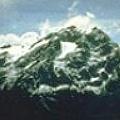 英國與烏干達科學家17日於《地球物理學研究》發表的一項新研究指出,由於全球暖化現象加劇,非洲東部魯文佐裏(Rwenzori)山區內的赤道冰帽將於20年內溶化、消失。研究者針對魯文佐裏冰河進行為期10年之研究,並以第一手勘查結果作為該報告之內容。
英國與烏干達科學家17日於《地球物理學研究》發表的一項新研究指出,由於全球暖化現象加劇,非洲東部魯文佐裏(Rwenzori)山區內的赤道冰帽將於20年內溶化、消失。研究者針對魯文佐裏冰河進行為期10年之研究,並以第一手勘查結果作為該報告之內容。
研究人員發現這塊由冰河所覆蓋的區域,自1987~2003年為止已縮減一半,過去40年來氣溫節節升高造成冰河表層大量融解。他們發現自60年代開始,魯文佐裏山區的氣溫有明顯升高的趨勢,而降雪量卻沒有太大的改變。
魯文佐裏山亦稱為月山,座落於剛果共和國及烏干達的邊界,拔然高聳4公里在周圍的平原上,除了安地斯山脈外,這裡保留了世上僅存的4座熱帶冰原之一。這些山脈生長著稀有的植物諸如巨型石南屬植物以及瀕危動物諸如大象、黑猩猩等,以及89種森林鳥類。
廣大的雪原融解成的雪水,供給尼羅河的上游的水源網絡——高山河流、湖泊及濕地等。雪水供養著下游的農作物並提供水力發電使用。
西元2世紀時即建立起這座高山的傳奇地位,當時希臘地理學者托勒密提及這座位於非洲赤道的冰帽山:「月山的雪孕育了湖泊以及尼羅河的源頭。」
魯文佐裏冰河的首次調查約在1世紀前,當時冰河覆蓋的面積估計有6.5平方公里,目前只僅剩少於1平方公里的冰河面積,研究人員預估冰河將在20年內消失殆盡。
倫敦大學地理系教授泰勒指出,「就非洲大陸而言,其在全球溫室氣體排放量方面雖然微不足道,但很諷刺的是,根據目前的預測,非洲大陸卻是氣候變遷最大的受害者。」
 Equatorial icecaps in the Rwenzori Mountains of East Africa will disappear within 20 years because of global warming, new research by British and Ugandan scientists projects. In a paper published today in "Geophysical Research Letters", the researchers report results from the first survey of the Rwenzori glaciers conducted in a decade.
Equatorial icecaps in the Rwenzori Mountains of East Africa will disappear within 20 years because of global warming, new research by British and Ugandan scientists projects. In a paper published today in "Geophysical Research Letters", the researchers report results from the first survey of the Rwenzori glaciers conducted in a decade.
The researchers found that the area covered by glaciers shrank by half in the time period between 1987 and 2003. An increase in air temperature over the past 40 years has contributed to a substantial reduction in glacial cover, they say. They found that since the 1960s in the Rwenzori Mountains, there are clear trends toward increased air temperature without major changes in precipitation.
The Rwenzori Mountains, also known as the Mountains of the Moon, straddle the border between the Democratic Republic of Congo and the Republic of Uganda, rising four kilometers above the surrounding plain. They hold one of four remaining tropical ice fields outside of the Andes. These mountains shelter rare plants such as the giant heather and endangered animals such as elephants, chimpanzees, as well as 89 species of forest birds.
Their extensive snowfields produce meltwaters that supply a network of alpine rivers, lakes and wetlands that are a source of the River Nile. The meltwaters sustain agricultural production downstream and allow generation of hydroelectric power.
The mountains' legendary status was established during the second century, when the Greek geographer Ptolemy referred to the snow-capped mountains at the equator in Africa as, "The Mountains of the Moon whose snows feed the lakes, sources of the Nile."
The Rwenzori glaciers were first surveyed a century ago when glacial cover over the entire range was estimated to be 6.5 square kilometers. With less than one square kilometer of glacier ice remaining, the researchers expect these glaciers to disappear within the next 20 years.
"Considering the continent's negligible contribution to global greenhouse gas emissions," said Richard Taylor of the University College London Department of Geography, "it is a terrible irony that Africa, according to current predictions, will be most affected by climate change."






